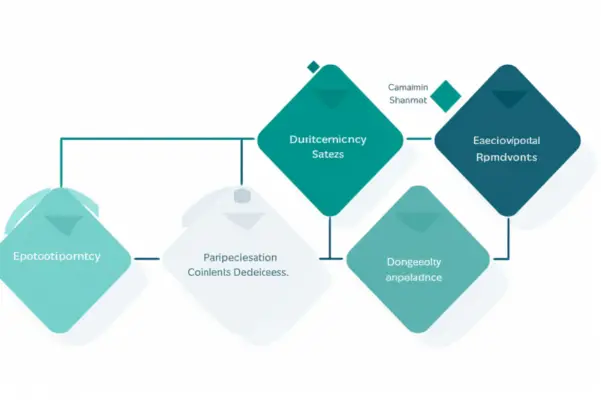Risk Control Self Assessment (RCSA) is essential because it is a process that helps organizations identify, assess, and manage risks to achieve their business objectives.
RCSA can also help raise awareness of operational risks and identify weaknesses in controls, thus enabling organizations to take corrective actions to mitigate risks.
According to FinLync, RCSA can play an important role in enhancing the organization’s risk management culture and improving its risk management framework. Additionally, RCSA can empower management and staff at all levels to collectively identify and manage risks, as explained by FinanceTrainingCourse.com.
In today’s rapidly evolving business landscape, organizations face an increasing array of risks that can undermine their success. To effectively manage these risks, a proactive and comprehensive approach is needed.
Risk Control Self Assessment (RCSA), is a vital tool for organizations to identify, evaluate, and mitigate risks.
This article explores why RCSA is essential, highlighting its benefits and examining the key components of a robust assessment process.
By implementing RCSA, businesses can enhance their risk management practices and safeguard their operations in an ever-changing world.

What is Risk Control Self Assessment?
Risk Control Self Assessment (RCSA) is a process that allows organizations to identify, assess, and mitigate risks within their operations.
It involves a systematic and comprehensive evaluation of potential risks, including both internal and external factors.
RCSA enables organizations to proactively manage risks, enhance decision-making, and improve overall operational efficiency.
Why Is It Essential?
What makes risk control self-assessment an essential practice in professional settings?
Risk control self-assessment is an essential tool in ensuring the effective management of risks within an organization. Here are three reasons why it is essential:
- Enhanced risk identification: Through risk control self-assessment, organizations can identify potential risks more comprehensively. This proactive approach allows them to address risks before they escalate into larger problems.
- Improved decision-making: Conducting regular risk control self-assessments provides organizations with valuable insights into their risk landscape. This enables informed decision-making, as management can prioritize risks and allocate resources accordingly.
- Strengthened risk management culture: Risk control self-assessment fosters a culture of risk awareness and accountability within an organization. Employees become more engaged in identifying and managing risks, leading to a more proactive and resilient organization.
Benefits of Risk Control Self-Assessment
Risk Control Self Assessment (RCSA) offers several benefits to organizations.
Firstly, it improves access to key information, allowing decision-makers to have a comprehensive understanding of risks.
Secondly, it increases visibility for senior management, enabling them to make more informed decisions and allocate resources effectively.
Lastly, RCSA enhances compliance with regulatory requirements by identifying and analyzing risks, ensuring the organization operates within legal and ethical boundaries.
Improved Access to Key Information
Enhancing access to vital information is a significant advantage of implementing risk control self-assessment. By conducting control self-assessments, organizations gain improved access to key information related to risk management and operational risks.
Here are three ways in which risk control self-assessment enhances access to key information:
- Comprehensive assessment: Through the use of control self-assessment questionnaires, organizations can gather detailed information about their risk landscape. This allows senior management to gain a holistic view of potential risks and vulnerabilities, enabling them to make informed decisions.
- Early identification: Risk control self-assessment helps in the early identification of potential risks. By regularly assessing and monitoring key risk indicators, organizations can proactively identify emerging risks and take corrective action before they escalate into major issues.
- Transparency and accountability: Implementing risk control self-assessment promotes transparency and accountability within an organization. It encourages employees to actively participate in risk management, providing valuable insights and information that might go unnoticed.
Increased Visibility for Senior Management
By providing senior management with increased visibility, risk control self-assessment enables them to have a comprehensive understanding of the organization’s risk landscape and make informed decisions.
This increased visibility allows senior management to have a clear view of the risks facing the organization, including their likelihood and potential impact. With this information, senior management can prioritize risks and allocate resources effectively to mitigate them.
Enhanced risk oversight is achieved through the ability to monitor and track risks in real-time, identifying emerging risks and taking proactive measures to address them.
Improved risk reporting provides senior management with accurate and timely information to facilitate decision-making.
This visibility also enables more effective risk management by identifying areas of weakness and implementing appropriate controls.
Additionally, senior management can conduct better risk assessments by understanding the interdependencies and potential cascading impacts of different risks. Overall, increased visibility through risk control self-assessment empowers senior management to navigate the organization’s risk landscape with confidence.

Enhanced risk identification and Analysis
With increased visibility for senior management, risk control self-assessment enhances the identification and analysis of risks within an organization.
This process offers several benefits that contribute to a more comprehensive understanding of potential risks and their impact on the organization’s objectives.
- Improved risk exposure assessment: Risk control self-assessment allows for a deeper understanding of the organization’s risk exposure by involving various stakeholders and encouraging their active participation in the risk assessment.
- Enhanced risk culture: By involving employees at all levels of the organization, risk control self-assessment fosters a strong risk culture where employees are more aware of potential risks and actively contribute to their identification and analysis.
- Better understanding of risk levels: Risk control self-assessment provides a systematic approach to assessing risk levels, enabling organizations to prioritize and allocate resources more effectively to mitigate the most critical risks.
Through the implementation of risk control self-assessment, organizations can enhance their operational risk management by empowering risk owners and promoting a proactive approach to risk identification and analysis.
Improved Understanding of the Control Environment
Risk control self-assessment gives organizations a clearer understanding of the control environment, enabling them to identify and address potential vulnerabilities within their operational processes.
By conducting risk control self-assessments, organizations can evaluate the effectiveness of their internal controls, ensuring that they are aligned with the organization’s risk appetite and business objectives.
This process allows operational risk managers to gain insights into the inherent risks within different business units and assess the adequacy of controls in mitigating these risks.
The improved understanding of the control environment also helps in determining the residual risk, which is the risk that remains after implementing controls.
This information is vital for organizations to make informed decisions and prioritize resources to address key risks.
Furthermore, risk control self-assessments contribute to the overall audit readiness of the organization by providing evidence of risk management processes and controls in place.
Enhanced Compliance with Regulatory Requirements
Enhanced compliance with regulatory requirements is a key benefit of risk control self-assessment. By implementing a risk control self-assessment process, organizations can improve their risk management capabilities and ensure effective risk management practices are in place.
Here are three ways risk control self-assessment enhances compliance with regulatory requirements:
- Improved risk identification: Risk control self-assessment enables organizations to identify potential risks and vulnerabilities. By identifying and assessing risks, organizations can take a proactive approach to address them and ensure compliance with regulatory requirements.
- Enhanced accountability for controls: Risk control self-assessment promotes a risk management culture by assigning responsibility and accountability for controls. This ensures that regulatory requirements are met and the necessary controls are in place to mitigate risks effectively.
- A better understanding of the risk environment: Through risk control self-assessment, organizations gain a deeper understanding of their risk environment. This enables them to align their processes and practices with regulatory requirements, reducing the likelihood of non-compliance.
More Efficient Use of Resources
One of the key benefits of risk control self-assessment is the ability to optimize resource utilization.
By conducting regular risk control self-assessments, organizations can identify and prioritize areas that require resource allocation, ensuring that resources are allocated efficiently and effectively.
Risk control self-assessment helps in identifying and assessing potential risks, allowing organizations to allocate resources to mitigate these risks and enhance the effectiveness of controls.
This proactive approach enables organizations to optimize the use of their resources by focusing on areas that pose the highest risk.
By understanding their risk profile through self-assessment, organizations can make informed decisions regarding resource allocation, ensuring that resources are directed towards areas that require attention the most.
This ultimately leads to a more efficient use of resources and better risk management.

Components of a Risk Control Self-Assessment Process
To effectively conduct a risk control self-assessment process, several key components need to be considered.
First, the identification and assessment of key risks is essential in order to understand the potential threats to the organization.
Second, the identification and analysis of internal controls allow for the evaluation of existing measures in place to mitigate risks. Additionally, evaluating the effectiveness of these controls is crucial to ensure they provide the desired level of protection.
Furthermore, reviewing existing policies and procedures helps identify areas for improvement while developing key risk indicators (KRIs) enables the organization to monitor and manage risks proactively.
Identification and Assessment of Key Risks
A crucial step in the risk control self-assessment (RCSA) process is the identification and assessment of key risks using a comprehensive and systematic approach.
This step helps organizations identify potential risks that could affect their processes, objectives, decisions, and plans. By identifying and assessing key risks, organizations can develop strategies to mitigate or manage those risks effectively.
Here are three components of the identification and assessment of key risks in the RCSA process:
- Event Identification: Organizations must identify events impacting their operations and objectives. This involves analyzing internal and external factors that could lead to risks.
- Risk Assessment: Once the events are identified, organizations need to assess the potential impact and likelihood of each risk. This involves evaluating the severity of the risk and the effectiveness of existing controls.
- Testing and Monitoring: Organizations should continuously test and monitor the effectiveness of their risk management strategies. This helps ensure the identified risks are properly controlled and managed within the enterprise risk management framework.
Identification and Analysis of Internal Controls
The identification and analysis of internal controls is a crucial component of the risk control self-assessment process.
It allows organizations to evaluate the effectiveness of their existing risk management strategies. Through this process, organizations can identify and analyze the control measures in place to manage risks.
By evaluating the internal controls, organizations can assess their ability to mitigate risks and identify any gaps or weaknesses in their risk management program. This analysis helps organizations develop a corrective action plan to address any deficiencies in their internal controls and improve their risk management practices.
Additionally, the identification and analysis of internal controls enable organizations to conduct a comprehensive risk assessment and determine the appropriate risk treatment strategies. This leads to a more robust and effective risk management program.
Evaluation of the Effectiveness of Controls
During the evaluation of the effectiveness of controls in a risk control self-assessment process, organizations can assess the adequacy and efficiency of their internal control measures in mitigating risks and improving their overall risk management practices.
This evaluation helps organizations determine if their controls are functioning as intended and if they are effectively managing their risks.
Here are three key steps in evaluating the effectiveness of controls:
- Assessing the design of controls: Organizations must evaluate whether their control measures are appropriately designed to address the identified risks. This involves reviewing the control objectives, activities, and environment to ensure they align with the organization’s approach to risk management.
- Testing the operating effectiveness of controls: Organizations must test the controls to ensure they are operating effectively. This can be done through various methods, such as performing walkthroughs, inspections, and testing of transactions to verify that the controls are functioning as intended.
- Collecting feedback through structured questionnaires: Organizations can gather feedback from employees and stakeholders through structured questionnaires to evaluate the effectiveness of controls. This feedback can provide valuable insights into any areas that may need improvement or adjustments to ensure the controls are effectively mitigating risks.
Reviewing Existing Policies and Procedures
One crucial step in a risk control self-assessment process involves reviewing the existing policies and procedures to ensure their alignment with the organization’s risk management objectives.
By conducting a thorough review, organizations can identify any gaps or inconsistencies in their policies and procedures that may hinder effective risk control. This step is essential as it allows organizations to assess the effectiveness of their current risk control measures and make any necessary adjustments.
To facilitate the review process, organizations can use a risk control self-assessment table, such as the one shown below, to evaluate the alignment of their existing policies and procedures with their risk management objectives:
| Risk Management Objective | Existing Policies and Procedures | Alignment |
|---|---|---|
| Objective 1 | Policy A | Yes |
| Objective 2 | Procedure B | No |
| Objective 3 | Policy C | Yes |
This table helps organizations visualize the alignment of their existing policies and procedures with their risk management objectives, enabling them to identify areas that require improvement.
Through this review process, organizations can ensure that their risk control measures are effective and aligned with their overall risk management strategy.
Developing Key Risk Indicators (KRIs)
What role do Key Risk Indicators (KRIs) play in the risk control self-assessment process?
Developing Key Risk Indicators (KRIs) is an essential step in the risk control self-assessment process. These indicators provide a quantitative or qualitative measure of potential risks within an organization.
Here are three ways in which KRIs contribute to the risk control self-assessment process:
- Early warning system: KRIs act as an early warning system by identifying and monitoring potential risks before they become significant issues. This allows organizations to take proactive measures to mitigate these risks.
- Performance measurement: KRIs provide a means to measure the effectiveness of risk control strategies and the overall risk management framework. By tracking key indicators, organizations can assess whether their risk control efforts achieve the desired outcomes.
- Decision-making tool: KRIs provide valuable information for decision-making processes. By analyzing the trends and patterns in KRIs, organizations can make informed decisions regarding risk mitigation strategies and resource allocation.
Developing effective KRIs is crucial for organizations to proactively manage risks and ensure the success of their risk control self-assessment process.
Frequently Asked Questions
How Can an Organization Effectively Implement and Maintain a Risk Control Self-Assessment Process?
An organization can effectively implement and maintain a risk control self-assessment process by establishing clear objectives, conducting regular assessments, involving all relevant stakeholders, documenting findings, and using the results to inform decision-making and improve risk management strategies.
What Are Some Common Challenges or Obstacles Faced When Conducting a Risk Control Self-Assessment?
Some common challenges or obstacles faced when conducting a risk control self-assessment include lack of employee engagement, limited resources, difficulty in identifying all potential risks, and ensuring consistency in the assessment process.
Are There Any Regulatory Requirements or Standards That Organizations Should Consider When Implementing a Risk Control Self-Assessment Process?
Organizations should consider regulatory requirements and standards when implementing a risk control self-assessment process.
Compliance with these guidelines ensures the effectiveness and credibility of the assessment, enabling organizations to identify and mitigate risks effectively.
How Can a Risk Control Self-Assessment Process Help Identifying and Mitigating Emerging Risks?
A risk control self-assessment process helps in identifying and mitigating emerging risks by allowing organizations to evaluate their current risk management practices and identify any gaps or weaknesses.
It provides a proactive approach to risk management and enables timely and effective risk mitigation strategies.
What Role Does Senior Management Play in the Risk Control Self-Assessment Process, and How Can They Support Its Effectiveness?
Senior management plays a crucial role in the risk control self-assessment process by providing guidance, resources, and support.
Their involvement ensures the effectiveness of the process and helps in addressing emerging risks proactively.

Conclusion
Risk Control Self-Assessment is essential because it allows organizations to identify and manage risks proactively.
It provides a structured approach for assessing potential threats and vulnerabilities, enabling businesses to implement appropriate control measures.
Engaging employees at all levels of the organization in the assessment process, it promotes a culture of risk awareness and accountability.
Ultimately, Risk Control Self Assessment helps organizations improve their risk management practices and enhance overall business performance.

Chris Ekai is a Risk Management expert with over 10 years of experience in the field. He has a Master’s(MSc) degree in Risk Management from University of Portsmouth and is a CPA and Finance professional. He currently works as a Content Manager at Risk Publishing, writing about Enterprise Risk Management, Business Continuity Management and Project Management.

